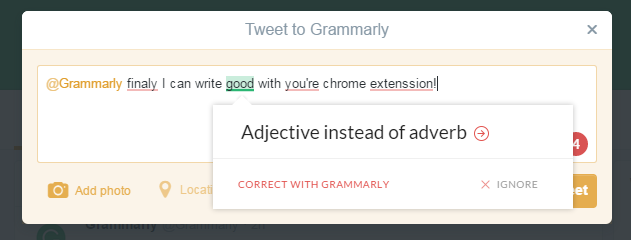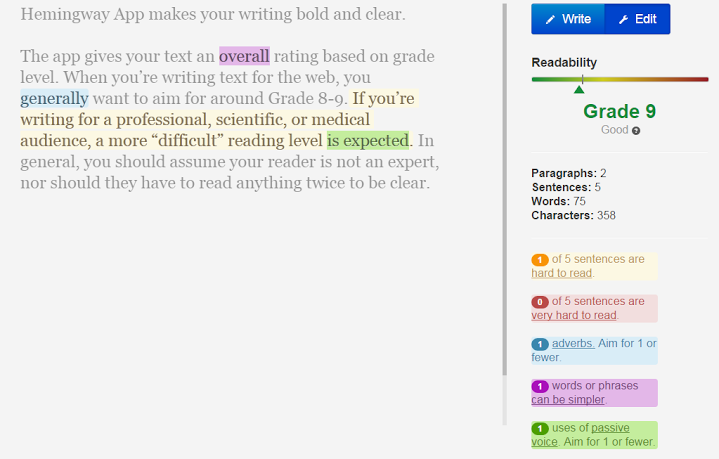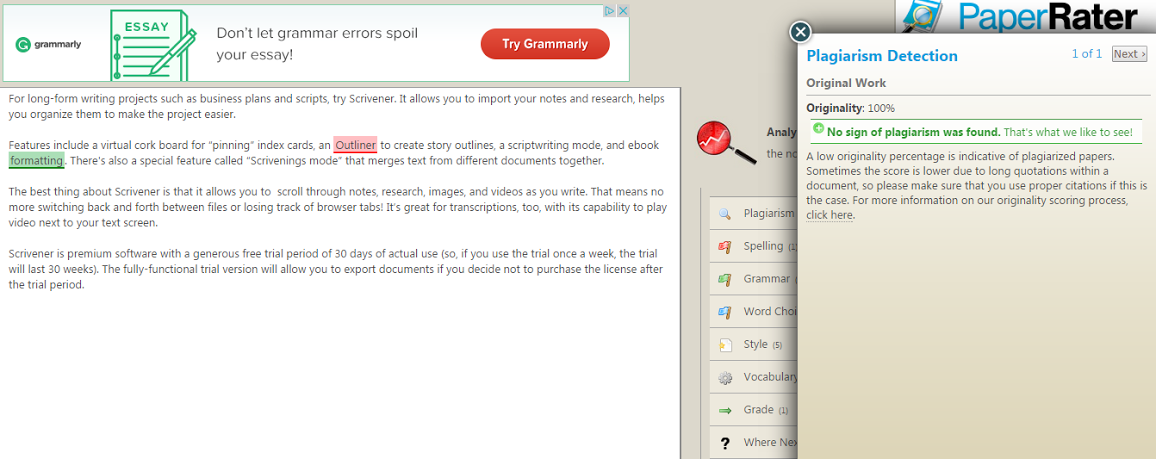
When you have a small business, there are times when you have to write something, like it or not. It would be nice to be able snap your fingers and have a comfortably-paid assistant do every bit of writing for you, but until you reach that level, it’s on you.
No pressure!
But even small things like email and social media posting should be clean and professional.
If you’re like a lot of small business owners, you’re responsible for writing a lot more than emails: business letters, blog posts, employment ads, even basic advertising.
[show_to accesslevel=’free’]
Chances are, you don’t have a professional editor on the payroll to make sure your writing is ready to go (a once-over by an employee or family member probably won’t cut it).
Spellcheck is well and good — it should be automatic. But, while built-in spell checkers can save you from embarrassing typos and misspellings a lot of the time, they can’t make your writing better, clearer, or more effective.
Luckily, there are tools out there that can. Don’t believe a free online tool can improve your writing? Try these 6 applications and see the difference it makes.
6 Free Writing Tools That Will Make You a Better Writer
1. Grammarly
You might think your grammar is impeccable. Maybe it is, and you never make a slip, other than the rare typo. It still doesn’t hurt to use Grammarly, a free extension for Chrome and Microsoft Office Add-in that finds significantly more errors than a built-in spell checker.

Once upon a time, you had to copy and paste your text into a tool on grammarly.com. Now, once you have the handy extension installed, you don’t have to do anything on enabled pages — any possible errors are automatically underlined.
Simply hover over the underlined word to see the issue, and a possible solution. The extension will enable itself on most social media pages, such as Facebook and Twitter, blog platforms like WordPress, Gmail, and most pages where you insert text.
For pages that don’t work with the extension, click on the icon, then “New Document.” The editor will open in a new tab, where, you can paste your copy to check for errors.
In addition to the online extension, Grammarly has an Add-in for Microsoft Office, to quickly check your your offline documentation.
2. Hemingway App
Remember in school, when you learned to use active voice?
Or that adverbs should be used sparingly?
You probably remember the part about run-on sentences, but do you recognise it when you do it?

Hemingway App proofs your writing for clarity and readability. You may have no spelling or grammar errors, but, chances are, there are parts of your text that can be simplified.
The app gives your text an overall rating based on grade level.
When you’re writing text for the web, you generally want to aim for around Grade 8-9. If you’re writing for a professional, scientific, or medical audience, a more “difficult” reading level is expected.
In general, you should assume your reader is not an expert, nor should they have to read anything twice to be clear.
You might be shocked at how much is highlighted the first time you use HemingwayApp. Just keep in mind, you know your audience best. If they respond to conversational writing, use your judgement when making changes.
If that adverb or instance of passive voice is really necessary to fit with your tone, you don’t have to get rid of it. Just being able to see these things highlighted can help you to recognise patterns in your writing that might need improvement.
3. Wordcounter.net
Most word processors have a word counter, a handy tool that tells you how many words are in a body of text.
Often, with blog posting and SEO, the word count matters.

Wordcounter.net does the obvious, but it takes it further: the tool also shows the number of sentences, the average number of words per sentence, and it displays the 10 words most frequently used in the text (aka Keyword Density).
Keyword density can be a big help with SEO, and it can also help you see at a glance if you use certain words repetitively.
If you have a habit of using the same word over and over to the point of redundancy, or if you inadvertently repeat words in your long-tail keywords to the point that it Google might consider it excessive, Wordcounter is invaluable.
4. Draft
Sometimes automated editors just aren’t enough. Draft is a free, feature-rich supertool that simplifies real-person editing, and (much) more.
Have you ever shared a document with colleagues via Google Docs, allowing them editing capabilities, only to find that your original draft has been the victim of too many chefs in the kitchen?

When you share via Draft, your sharees can edit to their hearts’ content — and you’ll have the option to accept or deny the changes. If you don’t have anyone to supply feedback, you can click on “Ask a Professional” to get suggestions from a real live reviewer.
Draft integrates with cloud platforms such as Google Docs and Evernote, so all of your work is backed up.
And when you’re ready to publish, whether it be to WordPress, Blogger, Facebook, or another blog or social media platform, you can do it right from Draft.
There are lots of other features, including an audio transcription tool, email-to-Draft converter, a presentation creator, analytics, and what they call “Hemingway mode,” (not to be confused with the HemingwayApp mentioned above).
This prevents you from editing while you write your first draft, forcing you to save the editor mindset for later.
Draft works in your regular or mobile browser, with an optional Chrome extension.
5. Scrivener
For long-form writing projects such as business plans and scripts, try Scrivener. It allows you to import your notes and research, helps you organize them to make the project easier.
Features include a virtual cork board for “pinning” index cards, an Outliner to create story outlines, a scriptwriting mode, and ebook formatting.
There’s also a special feature called “Scrivenings mode” that merges text from different documents together.
The best thing about Scrivener is that it allows you to scroll through notes, research, images, and videos as you write — no more switching back and forth between files or losing track of browser tabs! It’s great for transcriptions, too, with its capability to play video next to your text screen.
Scrivener is premium software with a generous free trial period of 30 days of actual use (so, if you use the trial once a week, the trial will last 30 weeks). The fully-functional trial version will allow you to export documents if you decide not to purchase the license after the trial period.
6. PaperRater

If you blog or write articles regularly, PaperRater is a free tool that quickly analyzes your writing and gives automated feedback and suggestions.
It’s designed for academic papers, so the focus is less on keeping things simple like the Hemingway App. In fact, PaperRater tells you to do the opposite of Hemingway by encouraging the use of vocabulary words and transitional phrases.
It prefers prose on the purple side — a high rating on PaperRater won’t necessarily mean your text is clean and effective for the web.
Where PaperRater really comes in handy is with its plagiarism checker.
We’re not suggesting you would lift copy from someone else’s website, but sometimes certain phrases are so common in an industry that they can be mistaken for plagiarism.
This, of course, is something you want to avoid with SEO, even if it’s clear coincidence. Phrases that come up as unoriginal can hurt your Page Rank. A quick run through Paper Rater will set your mind at ease.
To use, cut and paste your copy into the text box and answer a few questions about the type of text it is (you may also be asked to answer a one-question survey — but hey, it’s free).
Do you have a writing tool you can’t live without? Tell us about it in the comments.
[/show_to]
[hide_from visible_to=’public’]
Sorry, access to this special content
is for ‘Owners’ only
Owners log in
here
Not a member of
the Owners Club yet?
[/hide_from]
